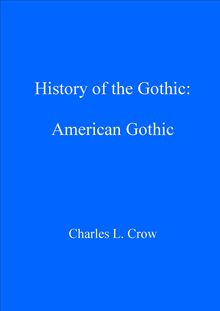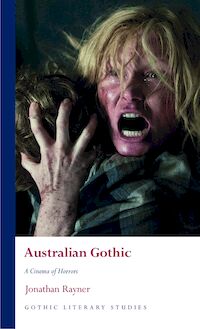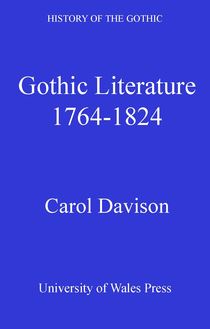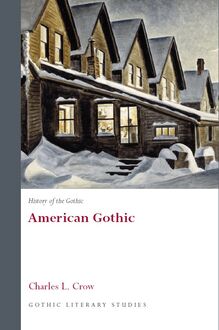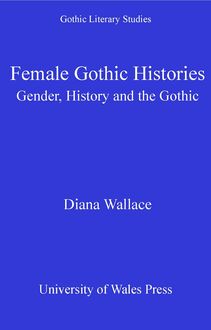Gothic Utterance , livre ebook
135
pages
English
Ebooks
2021
Vous pourrez modifier la taille du texte de cet ouvrage
Obtenez un accès à la bibliothèque pour le consulter en ligne En savoir plus
Découvre YouScribe en t'inscrivant gratuitement
Découvre YouScribe en t'inscrivant gratuitement
135
pages
English
Ebooks
2021
Vous pourrez modifier la taille du texte de cet ouvrage
Obtenez un accès à la bibliothèque pour le consulter en ligne En savoir plus
Publié par
Date de parution
15 juin 2021
Nombre de lectures
3
EAN13
9781786837561
Langue
English
The Gothic has always been interested in strange utterances and unsettling voices – from half-heard ghostly murmurings and the admonitions of the dead, to the terrible cries of the monstrous nonhuman. Gothic Utterance is the first book-length study of the role played by such voices in the Gothic tradition, exploring their prominence and importance in the American literature produced between the Revolutionary War and the close of the nineteenth century. The book argues that the American Gothic foregrounds the overpowering affect and distressing significations of the voices of the dead, dying, abjected, marginalised or nonhuman, in order to undertake a sustained interrogation of what it means to be and speak as an American in this period. The American Gothic imagines new forms of relation between speaking subjects, positing more inclusive and expansive kinds of community, while also emphasising the ethical demands attending our encounters with Gothic voices. The Gothic suggests that how we choose to hear and respond to these voices says much about our relationship with the world around us, its inhabitants – dead or otherwise – and the limits of our own subjectivity and empathy.
Introduction: American Biloquism
Part I: Gothic Utterance and Selfhood
1. Deadly Locution and Delphic Shrieks: Haunted Significance and the Self
2. Cries and Whispers: Spectral Voice, Community and Gothic Consciousness
Part II: Voices, Soundscapes, Histories
3. Howls and Echoes: Frontier Gothic and the Voice of the Wilderness
4. (Dis)embodied Utterance and the Peripatetic Voice: Hearing the Haunted Plantation
5. Squawking Soldiers and the Babbling Corpse: War-torn Words and Civil War Gothic
Conclusion: Quoth the Gothic
Publié par
Date de parution
15 juin 2021
Nombre de lectures
3
EAN13
9781786837561
Langue
English
GOTHIC UTTERANCE
SERIES PREFACE
Gothic Literary Studies is dedicated to publishing groundbreaking scholarship on Gothic in literature and film. The Gothic, which has been subjected to a variety of critical and theoretical approaches, is a form which plays an important role in our understanding of literary, intellectual and cultural histories. The series seeks to promote challenging and innovative approaches to Gothic which question any aspect of the Gothic tradition or perceived critical orthodoxy. Volumes in the series explore how issues such as gender, religion, nation and sexuality have shaped our view of the Gothic tradition. Both academically rigorous and informed by the latest developments in critical theory, the series provides an important focus for scholarly developments in Gothic studies, literary studies, cultural studies and critical theory. The series will be of interest to students of all levels and to scholars and teachers of the Gothic and literary and cultural histories.
SERIES EDITORS
Andrew Smith, University of Sheffield
Benjamin F. Fisher, University of Mississippi
EDITORIAL BOARD
Kent Ljungquist, Worcester Polytechnic Institute Massachusetts
Richard Fusco, St Joseph s University, Philadelphia
David Punter, University of Bristol
Chris Baldick, University of London
Angela Wright, University of Sheffield
Jerrold E. Hogle, University of Arizona
For all titles in the Gothic Literary Studies series visit www.uwp.co.uk
Gothic Utterance
Voice, Speech and Death in the American Gothic
Jimmy Packham
Jimmy Packham, 2021
All rights reserved. No part of this book may be reproduced in any material form (including photocopying or storing it in any medium by electronic means and whether or not transiently or incidentally to some other use of this publication) without the written permission of the copyright owner. Applications for the copyright owner s written permission to reproduce any part of this publication should be addressed to the University of Wales Press, University Registry, King Edward VII Avenue, Cardiff CF10 3NS.
www.uwp.co.uk
British Library Cataloguing-in-Publication Data A catalogue record for this book is available from the British Library.
ISBN 978-1-78683-754-7 e-ISBN 978-1-78683-756-1
The right of Jimmy Packham to be identified as author of this work has been asserted in accordance with sections 77 and 79 of the Copyright, Designs and Patents Act 1988.
The publisher has no responsibility for the persistence or accuracy of URLs for any external or third-party internet websites referred to in this book, and does not guarantee that any content on such websites is, or will remain, accurate or appropriate.
Cover image: Gustave Dor , The Raven (1882), engraving for an 1884 edition of Edgar Allan Poe s The Raven . Retrieved from the Library of Congress.
For Imogen and my parents
C ONTENTS
Acknowledgements
A note on referencing
Introduction: American Biloquism
Part I: Gothic Utterance and Selfhood
1 Deadly Locution and Delphic Shrieks: Haunted Significance and the Self
2 Cries and Whispers: Spectral Voice, Community and Gothic Consciousness
Part II: Voices, Soundscapes, Histories
3 Howls and Echoes: Frontier Gothic and the Voice of the Wilderness
4 (Dis)embodied Utterance and the Peripatetic Voice: Hearing the Haunted Plantation
5 Squawking Soldiers and the Babbling Corpse: War-torn Words and the Civil War Gothic
Conclusion: Quoth the Gothic
Notes
Bibliography
A CKNOWLEDGEMENTS
There are many voices - some of them Gothic, some less so, all of them kind and generous - that have informed my own in the writing of this book. There is not room enough here to thank them all individually, but there are a few I would like to highlight. Thanks are due first to David Punter, who supervised a very different iteration of this research project during my doctoral studies at the University of Bristol. The entirety of the English Department at Bristol is to be thanked, too, for the generosity and encouragement provided during this period and beyond; I am particularly grateful for the guidance and friendship of Laurence Publicover, Tamsin Badcoe, Ians Burrows and Calvert, Stephen James, Theo Savvas, Lesel Dawson, Pam Lock, Jen Baker and Joan Passey - and all of Pathway 4 . At the University of Birmingham, thanks are due to Andrzej Gasiorek, Tom Lockwood and Deborah Longworth, for their support during the writing of this project, and to Dorothy Butchard, Melissa Dickson, Ellie Dobson, John Fagg, Fariha Shaikh and Matthew Ward for their conversation and comments on early drafts of this work. I am thankful to Sarah Lewis, Dafydd Jones, Andy Smith and Jeffrey Andrew Weinstock at UWP for their kindnesses, assistance and helpful feedback. Any errors that remain are, of course, my own. A special mention is due to Richard Vigars (for the music) and Mark Puttick (for the movies). To my parents, Sarah and Kevin, I am indebted in ways that will never be adequately repaid. I am grateful to Alfred, for reminding me that not all animal utterances are Gothic. Finally, with love: Imogen Peck, to whom I owe the greatest part of my happiness.
A note on referencing
Where, across directly successive sentences, quotations are drawn from a single source, I have adopted a single endnote, following the final quotation, in order to indicate the location(s) of the quoted material; this is intended to prevent the text (and reader) from becoming overwhelmed by endnotes in particular passages.
Introduction: American Biloquism
At the heart of America s Gothic tradition is the horror of the voice. Charles Brockden Brown s foundational American Gothic novel, Wieland; or, The Transformation: An American Tale (1798), concerns a family haunted by an array of strange, disembodied utterances. Theodore Wieland interprets these utterances as coming from God and is impelled by them to murder his wife and children and finally, following an admonition from another disembodied voice explaining that he has been misled by his senses, to kill himself. These events play out alongside the arrival of a stranger, Carwin, who finally admits to Clara Wieland, the narrator, that he is a biloquist - somebody who can mimic exactly the voice of another and modify the sound so that it shall appear to come from what quarter, and be uttered at what distance [they] please . 1 Carwin confesses to deliberately terrorising the Wielands by ventriloquising their voices and by speaking to them in other voices, which are by turns threatening and seemingly benevolent. Yet he denies using his powers to urge Theodore to commit murder; this voice remains strangely unaccounted for.
The Gothic voices of Wieland invite a rich array of interpretations. They might, for instance, signify the voices of any of the following: God, the demonic, the fanatic, the subconscious, the abjected, the dead, authority (or its absence), the emergent republic (as this American tale unfolds between the French and Indian War and the Revolution), the old world (as Carwin is initially presented as an Englishman by birth), the native American (a term Carwin applies to himself), the mesmerist or the automaton (for more than once Carwin generates in his auditors, and admits that he responds to, mechanical impulses) and so on. As this ambiguity suggests, Carwin s voice is unruly; its horrors proceed not just from what this voice says, but from its tenuous relationship to the speaking subject. At its wildest, this voice is louder than human organs could produce, shriller than language can depict . 2 But, for all its extremity and excess, this Gothic voice sits uncomfortably close to the more conventional voices of the novel; and it exists within a narrative that continually meditates on the quality of all voices. Prior to Carwin s arrival, Theodore, a good young American citizen, spends his time practicing his elocution, reciting Cicero s writings, anxious to discover the gestures and cadences with which they ought to be delivered and very scrupulous in selecting a true scheme of pronunciation for the Latin tongue . With his friend, Henry Pleyel, Theodore spends time bandying quotations and syllogisms and arguing over appropriate word choices during dramatic recitations. 3 In short, what one says and how one says it matters in Brown s America.
Moreover, Carwin s own conventional speaking voice is disarmingly beautiful. It was wholly new , remarks Clara: The voice was not only mellifluent and clear, but the emphasis was so just, and the modulation so impassioned, that it seemed as if an heart of stone could not fail of being moved by it . 4 Carwin s voice is a site of both Gothic terror and sublime beauty; it is the ideal voice and this ideal s own dark doppelg nger. In this respect, Carwin s is not merely the aberrant voice intruding into the ordinary and wellmannered world. Rather, as a vehicle for hypnotic beauty and disruptive terror, it embodies the fullest possible potential of the voice; in turn, this voice is that which all other voices strive to emulate and, at the same time, it dramatises the notion that any voice might become disorderly and dangerous: biloquism is an art which may be taught to all , Carwin speculates ominously. 5 And beyond all this remains that one voice Carwin will not acknowledge as his own, the voice Theodore ascribes to God - that voice which cannot be located or contained and which gestures irrevocably towards death.
It is the wealth of haunted and haunting voices emanating from the pages of American Gothic writing with which this book is concerned. My focus in particular is on the writing of the late eighteenth and the nineteenth centuries, from the emergence of the Gothic tradition following the Revolutionary War to the meditations offered in Gothic fiction on the Civil War and the postbellum United States. I hope through this approach to foreground the absolute centrality of the voice and its utterances


